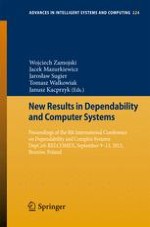DepCoS – RELCOMEX is an annual series of conferences organized by the Institute of Computer Engineering, Control and Robotics (CECR), Wrocław University of Technology, since 2006. Its idea came from the heritage of the other two cycles of events: RELCOMEX Conferences (1977 – 89) and Microcomputer Schools (1985 – 95) which were then organized by the Institute of Engineering Cybernetics, the previous name of CECR. In contrast to those preceding meetings focused on the conventional reliability analysis, the DepCoS mission is to develop a more comprehensive approach to computer system performability, which is now commonly called dependability. Contemporary technical systems are integrated unities of technical, information, organization, software and human resources. Diversity of the processes being realized in the system, their concurrency and their reliance on in-system intelligence significantly impedes construction of strict mathematical models and calls for application of intelligent and soft computing methods. The submissions included in this volume illustrate variety of problems that need to be explored in the dependability analysis: methodologies and practical tools for modeling, design and simulation of the systems, security and confidentiality in information processing, specific issues of heterogeneous, today often wireless, computer networks, or management of transportation networks.
